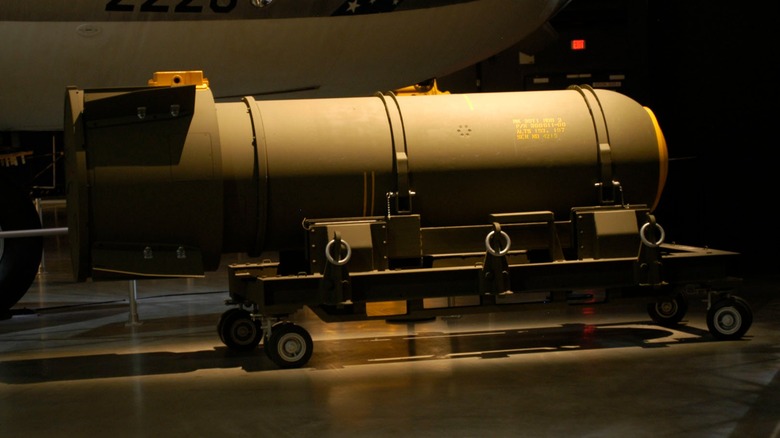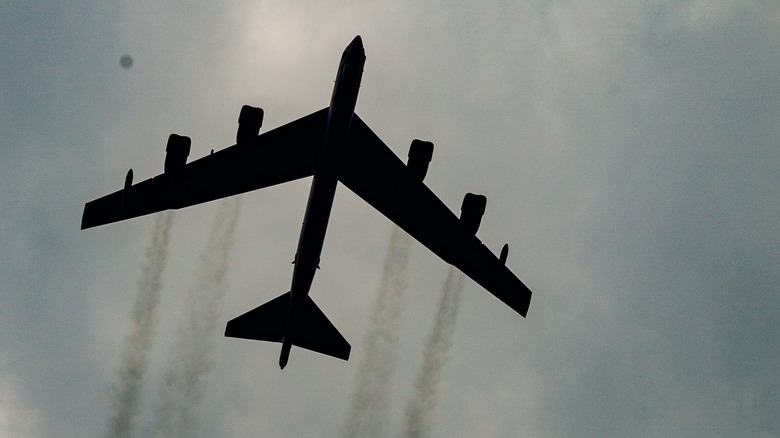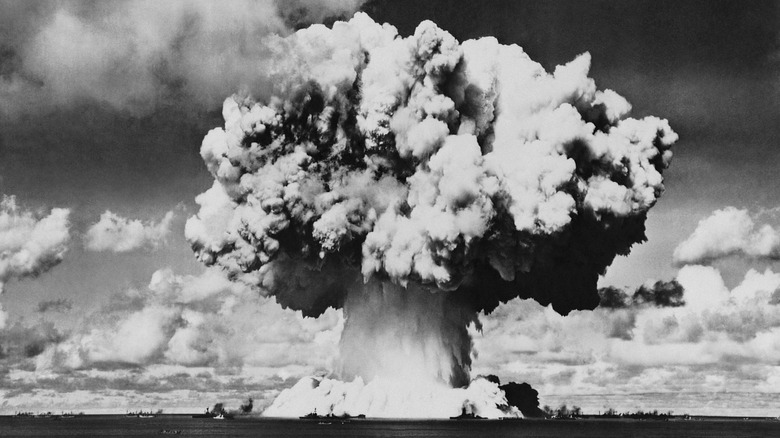The Time A Nuclear Nightmare Almost Took Place In North Carolina
Amid the whirring of helicopter blades, licking flames, and choking smoke from the wreckage of a crashed B-52 Bomber, a voice over a loudspeaker repeated its warning: "Evacuate." It was early in the morning of Jan. 24, 1961, and the U.S. Air Force bomber, one wing missing, trailing flaming debris, just crash-landed near the farm of 17-year-old Billy Reeves and his family in Goldsboro, North Carolina, according to National Geographic.
Reeves witnessed the crash and the ensuing explosion, and soon many others joined him to watch the raging blaze. It looked like "the world was on fire," one resident recalled, per the Goldsboro News-Argus. When the military helicopter hovering over the crash site gave its warning, Billy and his family did as they were told. "We didn't know why. We didn't ask why," he told National Geographic in 2021. "We just got out of there." What the Reeves were unaware of but that the world would soon learn (at least what information the U.S. government was willing to divulge) was that there were two multi-megaton Mark (MK) 39 hydrogen bombs on board the plane, per the National Security Archive of George Washington University.
A fuel leak that nearly caused a nuclear disaster
On the night of Jan. 23, 1961, a B-52 Bomber was in the air for about 10 hours on a circular route around the east coast when it began leaking fuel. Major Walter Tulloch, its commander, attempted to make it back to the Seymour Johnson Air Force Base in Goldsboro when the plane went into a spin and began breaking apart, according to Eric Schlosser's 2014 book, "Command and Control: Nuclear Weapons, the Damascus Accident, and the Illusion of Safety." Five crewmembers, including Tulloch, survived, but three others died in the accident, per the South Carolina-based newspaper, The State.
During the bomber's breakup, one of the nuclear bombs fell from the plane. It floated to earth on its parachute, the process to arm the weapon engaged, and it landed nose first into the ground in a field near Faro, North Carolina. Only one of four safety mechanisms to prevent an unintended detonation engaged, per The Guardian. The other bomb's parachute didn't deploy, and it sailed down in free fall, slamming into the ground, the impact arming the weapon as it sunk 70 feet into the swampy ground. However, its failsafe devices worked, per Schlosser.
Could have been worse than reported
Had just one of the two nuclear weapons detonated, the ensuing destruction would have been 200 times worse than the devastation unleashed by the bombs the U.S. dropped on Hiroshima and Nagasaki in 1945, according to Forbes. "This bomb had the potential to make the one used in Hiroshima look like the work of a cap gun," Eric Schlosser told Fox News in 2015. Deadly fallout would have rained down along the East Coast, including on Washington, D.C., all the way to New York City, per The Guardian. After the accident, the U.S. government told the media that there was never any danger of a nuclear explosion, per The State.
It wasn't until Eric Schlosser uncovered government documents that told a different story of just how close a call it actually was. In the report, a U.S. government senior engineer determined that "one simple ... low voltage switch stood between the United States and a major catastrophe," per The Guardian. This wasn't the first near-nuclear weapon-related accident during the Cold War. In fact, it was the third such incident around North Carolina and Georgia in a three-year span, per The State. Eleven years before this accident, a U.S. bomber in Canada jettisoned a bomb like the one used on Nagasaki, about 150 miles from Quebec City, in November 1950. While the device exploded, it didn't have its plutonium core, according to Canada History.


